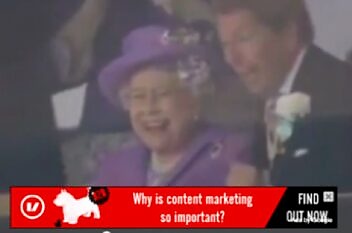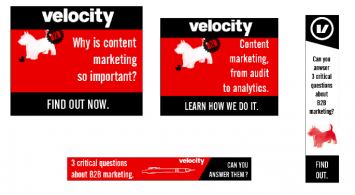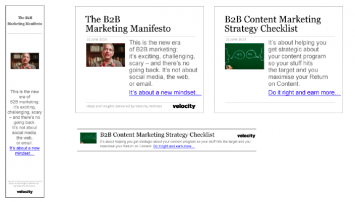Back in July, we reported on a B2B Content Remarketing experiment we’re doing with the people at Resonance.
This is the second post: the results.
To summarise, we wanted to find out if a certain kind of ad retargeting could work for B2B content marketing. So we worked with Resonance to design a test, in two phases:
Phase 1 – Run normal ‘product’ ads (in this case for our own services like Content Strategy) in a traditional retargeting program: everyone who came to our site got cookied and shown our product ads whenever they visited a website on the ad networks we chose. The ads looked like this (we let Resonance design and optimize them over time):
Phase 2 – Cookie our visitors and show them content ads (not product ads) in a pre-determined sequence. This ‘content funnel’ idea is key to the Resonance approach and it’s what made us want to give it a test drive. If people downloaded content piece #1, we only showed them ads for content piece #2. And so on until they’d consumed all five pieces of content (or until our budget and cookied population ran out).
The ads were more ‘editorial style’, though they didn’t try to mimic the home site editorial (a kind of sleazy tactic). We tested lots of ad creative, with and without a Velocity logo, and optimized over time.
We knew that Velocity’s web traffic is a bit low for this kind of thing – your pool of cookied people gets smaller at each step, so you need to start out with a big enough number. But we hoped we’d see enough data to tell us whether this content retargeting thing has potential. We did (and it does).
What we found out
I don’t want to show actual data here because things like click-through rates and engagement data are SO company- and campaign-specific that it would lead to people setting weird benchmarks. Instead I’ll summarise our results and if you really want the numbers, contact Marcin Grodzicki at Resonance and he can take you through them.
1. Product Remarketing yielded worse results than organic traffic
This was a bit of a surprise. Download rates, time on site and bounce rates were all significantly worse for the retargeted traffic than for our normal site traffic. We knew product remarking would not be a great fit for Velocity (our products are complex services not pet food), but we expected it to be a little better than organic traffic.
2. Content Remarketing dramatically out-performed product remarketing and normal site traffic.
– Over 4x better conversion (download) rates than product retargeting and 3x better than the site average.
– Almost 3x lower cost per download
– Over 3x longer Time on Site than Product Remarketing.
We expected the Resonance approach to be better, but 300% was eyebrow-raising.
3.The content funnel works.
The click-through rate, conversion rate and engagement metrics increased significantly with each step in the Content Funnel – showing a higher quality of leads with each step.
This clearly showed us the value of the funnel campaign vs simple (one step) retargeting. It works more like an ongoing conversation with a prospect than an old-school, ad-style interaction.
4. There were things we didn’t like
— The frequency of advertising felt too high at times.
— The placement of the ads on consumer websites (catching our users in ‘leisure mode’) felt awkward and potentially alienating.
— Retargeting existing clients made them feel like we were preaching to the converted (and wasting our ad spend).
Apparently, Resonance has implemented new technology that allows them to control for these issues. We think this is an important part of the solution. Even if you’re getting great click-throughs and engagement, you don’t want to piss people off.
Three use cases for Resonance-style content retargeting.
Bottom line: we like this technology and feel it could play an important role in getting B2B content discovered and consumed. In particular, we can see three pretty clear use cases:
1) The content funnel – as described in our experiment; If you’ve got lots of content to promote, this could be a great way to do it. Especially if your content is at least roughly mapped to purchase stages.
2) The product tour – using remarketing to get your the full product message across, one ad and one feature at a time. Again, it’s a logical progression that people opt into whenever they click, rather than a carpet-bomb.
3) Upselling current customers – targeting upgrades or cross-sales to people who already buy from you. Some businesses have fairly low-engagement relationships, so you need new ways to get people back to spend more with you. Funnel-style retargeting could work well here.
The Bottom Line
It’s going to get harder and harder to get your content and your offers discovered by the people most likely to respond to them. People who have already visited your site are many times more likely to re-engage than bog-standard homo sapiens.
Content retargeting, using a content funnel and progressive ads, feels like a powerful way to use get the right people back for more.
Yes, I still hate simplistic retargeting that stalks your prospects around the web, cudgeling them with your messages. But I can definitely see a role for this more intelligent, highly targeted approach.

Enjoyed this article?
Take part in the discussion










Comments
Ryan Skinner August 28th, 2013
Very interesting experiment, guys.
A few questions:
1. What was the conversion for your product retargeting? I think I remember clicking on the ad and came to an “About Velocity”-like page and only remember a phone number being offered. Was a phone call the conversion, or were you hoping to get people to download an e-Book or other content from the page? (correct me if I’m wrong on the look of the landing page).
2. What did the landing pages for the content funnel look like? Were these the same landing page as the product retargeting or did you (as I suspect) point those to the original content piece landing pages?
Perhaps including the landing pages offered based on each campaign or click would help clarify how this might have helped/hindered each approach.
Very excited by this approach to sharing content, though. I’ve heard that John Battelle’s Federated Media crowd is doing the same kind of development (or similar, at least).
Doug Kessler August 28th, 2013
Hi Ryan. Great questions. My answers:
1. Conversion for us was first, downloading the next piece of content and ultimately, signing up for our newsletter.
The product retargeting (phase 1) led to fairly generic pages, where call-to-action wasn’t optimized. This was definitely one of the reasons conversion was lower for this phase — but so were the engagement metrics. We did have content and newsletter offers on these landing pages but they weren’t prominent.
2. The content funnel landing pages were our existing content landing pages, so yes, they were much more optimised for conversion. I should have made that clear. In a way, it wasn’t a fair fight. But that is part of the point: so much web advertising asks for too much and leads to pages that aren’t optimised for conversion.
Content retargeting keeps the content offer front and center and drives conversion, one piece of content at a time.
Very good points though. Phase 1 and Phase 2 weren’t exactly apples to apples. And for complex, relationship-based services like ours, it’s even sillier to do ‘product’ advertising.
Still, I think we saw enough to feel that intelligent content retargeting can out-perform many other traffic sources. And it does make sense that this is true.
Thanks for reading, asking and sharing!
Marcin Grodzicki August 28th, 2013
Good questions Ryan and thanks for spreading the message. Doug’s answers are straight to the point. The factor that we confirmed independently is the growing level of engagement with each step, which is the effect of our approach/technology (and general logic of lead nurturing). Call it ad-driven-marketing-automation if you will (vs the regular email kind).
We will share more data as we go, to show how Resonance performs in all cases (content funnel, product tour etc.) vs other retargeting tools – you can follow us on Twitter (@resonancehq) or sign up on our (temporary) web page to get updates (http://resonancehq.com).
Ryan Skinner August 29th, 2013
Cool. Thanks for the responses, guys.
As you say, the concept of the content funnel’s the more interesting idea, and the one I’m very glad you tested. It feels like Marcin’s out in front of a very hot trend/idea. I found that reference from John Battelle and Federated Media that I’d mentioned. He’s calling it “peanut butter cup marketing” because why not? http://battellemedia.com/archives/2013/08/peanut-butter-cup-marketing-in-a-few-minutes.php
Will follow Resonance. Interesting stuff.
Doug Kessler August 29th, 2013
Thanks Ryan.
Looks like Federated Media might be on to a similar thing.
(And someone told John Batelle he had to dumb down his elevator pitch to one single, dated, consumer advertising metaphor.)
I expect we’ll see more of this content marketing and retargeting are made for each other.
Kieran Flanagan September 5th, 2013
Enjoyed this post guys. I don’t think it’s surprising that your content ads performed better than product ads. The subset of people who are further up the funnel and just looking for stuff, is always going to be a lot greater than people who are actually looking for a solution.
I think Avinash’s See-Think-Do model is a really great description of how you can break up all your marketing programs, including retargeting – http://www.kaushik.net/avinash/see-think-do-content-marketing-measurement-business-framework/. If you can work out what pages/actions on your site can be bucketed into the different phases, then you should be able to adopt both ads + messaging accordingly.
I also agree on tactics like this becoming more important to seed content as people get overwhelmed.
Doug Kessler September 6th, 2013
Thanks Kieran.
Yes, no surprise that content ads out-performed product ones.
Love the See-Think-Do framework — hadn’t seen that.
Action Fuel Pro Diet June 23rd, 2015
I visit day-to-day a few web pages and websites to read articles or reviews,
but this web site provides feature based posts.